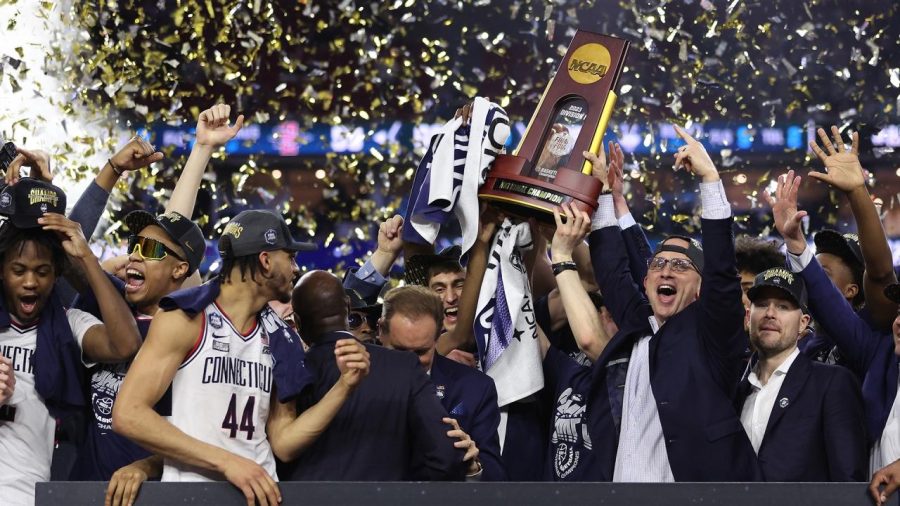2023 March Madness
The UConn Huskies celebrate their victory after winning their fifth NCAA Tournament in dominant fashion with a remarkable run.
Each March, thousands of people tune in to watch the NCAA Basketball Tournament. Whether to compete for the perfect brackets or to relatively enjoy the games, the tournament can become a madness, hence its name ‘March Madness.’ In a large bracket consisting of 64 teams, each team advances to the next round with a win or becomes eliminated from the tournament with a loss. After two wild weeks of college basketball, only four teams remain to compete for the National Championship: San Diego State, Miami Florida, UConn, and Florida Atlantic.
Ever since the beginning of the tournament back in 1939, many viewers have been attracted by the chaos and unpredictability of the tournament. Seeing a low-seeded team knock off a top powerhouse contender can bring excitement to almost each team’s fan base besides the losing team’s fans. It is almost inevitable for upsets to occur, especially if the underdogs gain their momentum at the right time. Because a team must win every game in order to win the entire tournament, each game is meaningful and brings out the competitive spirit of each player. Emery Sumberlin, a senior, says that the competitiveness of the tournaments makes it more entertaining for viewers to watch.
“I feel like the college teams competing and the close games and just seeing them go head to head makes it more fun to watch. I think games are more meaningful. It’s kind of like the playoffs, where if you lose one, then you’re out, so you need to win, and you want the recognition of being a winner. It makes the games more competitive and more entertaining to watch. You just go out there, and it’s just pure basketball,” said Sumberlin.
The madness of the tournament has also made it difficult for someone to predict a perfect bracket. Before the tournament begins, millions of people create their brackets, where they predict the winners of each game, hoping to make a perfect bracket for a large prize pool. But no one has ever had a perfect bracket since the NCAA organization has tracked online bracket submissions since 2016. In fact, the odds of getting a perfect bracket are 1 in 120.2 billion, which is near impossible. The closest someone has reached to a perfect bracket was back in 2019, when Gregg Nigl correctly predicted the winners of the first 49 games. Brandon Do, a sophomore, believes that upsets are bound to happen, making it hard to predict a perfect bracket.
“When a lower seed team upsets a higher seed team, it makes the tournament more exciting because we get to see newer teams get a chance to win it all and it just makes the fans more interested in rooting for their team,” said Do. “For me, I thought that there were good teams like Alabama was going to go on a good run. I also thought that Kansas had a great chance to repeat. Now that these teams are out of the tournament, it just goes to show how difficult it is to get a perfect bracket because anything can happen. Any team can win on any given day.”
This year’s madness was no different. It was the first time since the tournament expanded to 64 teams in 1985 that none of the No. 1-seeds reached the Elite Eight round. Before the start of the tournament, all of the No. 1-seeded teams opened up as the top four with the highest chances to win it all. However, in the Round of 64, the Fairleigh Dickinson Knights defeated the highly-powered Purdue Boilermakers, becoming the second ever 16-seed to upset a No. 1 seed since 1985. With Purdue as well as No. 2 seed Arizona Wildcats exiting early in the Round of 64, no perfect brackets remained after the first round. Furthermore, this year’s tournament has left an unprecedented, yet intriguing Final Four that consisted of unconventional teams. Sumberlin compares his predictions to the actual results of the tournament.
“All of the teams that I thought was going to be in the Final Four ended up not being there, so my predictions were kinda off. All the mid level schools started winning this year. I wanted Kansas State to win. I think it’s really nice to see other teams win other than the usual Gonzaga, UCLA, and all those other schools, so I feel like it’s a nice difference and kinda refreshing,” said Sumberlin.
With the remaining four teams, who all had historic runs to reach the Final Four, it was anyone’s tournament to win at that point. The Huskies come into the Final Four as the most experienced in the big stage and arguably the hottest team remaining, with multiple double-digit wins upon entering the tournament. With wins over Iona, Saint Mary’s, Arkansas, and Gonzaga, all of which came by at least 15 points, the Huskies look to win their fifth national championship since 1999. In the Elite Eight, the Huskies annihilated the most efficient offense in Gonzaga by 28 points, which was the biggest win in the Elite Eight since 1992. Offensively, the Huskies’ dominant interior forwards complement their efficient perimeter shooting from behind the arc, which could pose a challenge for the undersized Miami Hurricanes. For the Hurricanes, their path to the Final Four included two double-digit wins over heavily favored Houston and No. 4-seed Indiana. They will come into the Final Four as underdogs, but minimizing turnovers and tightening their defense to shut down the Huskies’ offense is something that they will need to rely on. Although undersized compared to the Huskies, if the Hurricanes are able to play quickly out in transition to get wide open looks, then it could be a game plan that works in their favor.
On the other side of the bracket, the other Final Four matchup consists of the San Diego Aztecs and the Florida Atlantic Owls. The San Diego State Aztecs, who defeated top ranked Alabama in the Sweet 16 and Creigton by one in the Elite Eight, will play in the Final Four for the first time in program history, hoping to win it all for the first time ever. Much of the Aztecs’ success comes from the elite defensive scheme and being able to slow the game down. They are ranked first in adjusted defensive efficiency and have been shutting down the top offenses throughout their tournament run. They will meet the Florida Atlantic Owls for the first set of the two Final Four matchups. Similarly, the Owls came into the tournament looking for both their first national championship and even their first win in the March Madness tournament. Upon reaching the Final Four, the Owls came back from deficits in each of their games. Although ranked a No. 9 seed, they have the most wins out of every other team in America this season. In contrast to the Aztecs, Florida Atlantic plays a faster-paced game, with a great all-around team that utilizes each of its starters and bench players to maintain the intensity of the game. Daevon Aikens, a sophomore, makes his predictions for both of the upcoming Final Four matchups.
“I got UConn because they have just been playing well with experience, but Miami has been making a lot of upsets, and I just don’t see the other two teams winning it, so I really want UConn to win, but I think that Miami might win it all,” said Aikens. “For the other game, I got FAU because they have been surprising everybody lately. FAU are the underdogs. They play with energy and surprise everybody and they have got nothing to lose, so they play the right way. They’re also willing to take beatings and do anything to win. Defense changes the game. Everybody will be able to score, but it’s mainly about being able to stop the other team, especially in college, where you have got to stop the other team so it’s not as easy to come back.”
With all that said, it was the Huskies that ultimately triumphed on cutting down the nets in Houston after a 76-59 victory over San Diego State on Monday night. Right from the start, the Huskies came out firing on all cylinders, gaining an early comfortable double digit lead as the Aztecs struggled shooting the ball from the field. Upon entering Monday night, the Aztecs played a draining 40 minutes against Florida Atlantic, only winning by one, while the Huskies once again dominated their opponent, the Miami Florida Hurricanes, in another double-digit victory. The Huskies used this to their advantage as they constantly wore down the Aztecs in the paint by utilizing their lengthy forwards. By halftime, UConn was up 36-24.
In the second half, the Aztecs pulled back with a few runs to close the margin down. They looked to make another comeback as they did in the Final Four against Florida Atlantic by going on a run to start the second half. However, towards the final ten minutes of the game, the Huskies broke away late as they knocked down a couple of threes and tightened up their defense to deny the Aztecs any chance of completing a comeback.
With another national championship in their collection, the Huskies have won their fifth national championship in the last 25 years. They proved their dominance throughout the entire tournament, steamrolling each of their opponents by double digits and winning by an average of 20 points. If the Huskies can reload once again over the off-season and be dominant with their young squad, then they could expect to make another deep run in next year’s March Madness Tournament.


